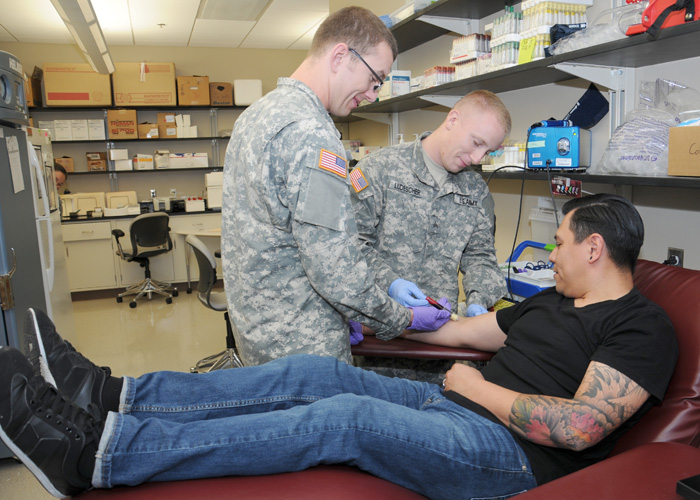Blood Bank Supports Blood Research

A biomedical science technician for the Coagulation and Blood Research (CBR) Task Area at the U.S. Army Institute of Surgical Research, Armando Rodriguez says that he puts his blood and sweat into his work—literally. Rodriguez has been donating blood to the CBR Blood Bank for more than three years. He is the bank's top donor, and his blood is being used for combat casualty care research.
"I'm proud to know that I am making a difference," said Rodriguez. "It makes me feel good to know that what I'm doing is going toward giving a wounded warrior the opportunity to make it home alive."
Spc. Dale Cmaylo, a medical laboratory specialist, helps collect blood from donors and distribute it to CBR and other Institute investigators.
"The research is priceless and important," he said. "The majority of the research on blood is on coagulation and the storage of fresh blood and platelets, a component of blood."
According to Cmaylo, the Institute's findings help both those wounded in combat and civilian trauma patients. Coagulation stops blood loss for a patient who is bleeding. Platelets aid in coagulation. These blood products are life-saving when patients are severely bleeding, particularly if they are given early. Cmaylo noted that providing them on the battlefield is challenging. He added that research on the storage of blood and its products is vital—especially for patients in austere environments where access to a hospital may be hours away.
"Blood is life," said Sgt. Eunjoo Kim, a CBR medical laboratory specialist. "We have to do the research to improve the shelf life and storage of platelets so that we can deliver good products to the battlefield."
Recently, the CBR Blood Bank added new types of collections that will increase the scope of blood research at the Institute. The bank maintains a list of donors. When an investigator requests a blood product, the medical laboratory specialists contact donors and collect the requester's item. Kim, aptly nicknamed "Vampire," said that she recruits new donors.
"It is very important that we support our researcher when they request blood products," said Kim. "We don't store blood unless it's for a researcher, so it's important that we have donors available when we get the requests."
Donors like Rodriguez can donate blood at any time, but there's a limit to how much and how often, which is why the CBR Blood Bank needs a large donor pool.
According to CBR Task Area Investigator Heather Pidcoke, there is a critical need to conduct a platelet study right now, yet researchers are limited by a shortage of platelet donors.
"We can only get one unit per donor every two months," said Cmaylo.
Recognizing this critical requirement, Rodriguez said that he'll continue donating blood in order to support blood research.
"We are at the forefront of science to optimize and improve outcomes during the 'Golden Hour' for the Soldiers," he said.
As long as there are donors like Rodriguez, Cmaylo will continue collecting blood for the same reasons.
"I feel like we're contributing to knowledge and future practices in medicine," said Cmaylo.














